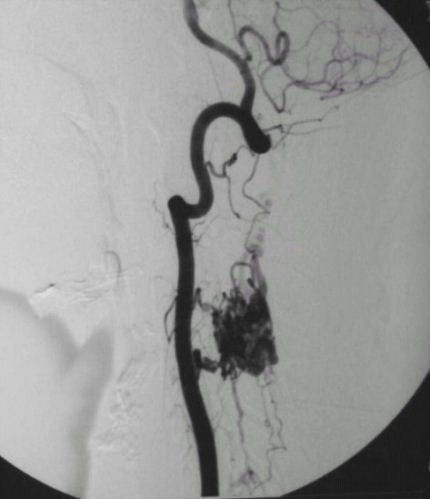
|
A 35 year-old man presented with slowly progressive quadriparesis and numbness of all four extremities. |

![]()
| Spinal Arteriovenous Malformation (AVM):
Cerebral Angiogram, left vertebral injection, lateral view. A
large arteriovenous malformation can be seen arising from the
vertebral artery (arterial feeders from both the intracranial
vertebral artery as well as the extracranial vertebral artery in the neck). Near the top of the picture, the
posterior inferior cerebellar artery (PICA) is seen arising from the
intracranial vertebral artery. Arteriovenous malformations
are a congenital abnormality of blood vessels, consisting of a
tangle of abnormal vessels supplied by arterial feeders and often
drained by large dilated veins. Spinal cord vascular malformations may be acquired or congenital. They are malformations of blood vessels in or around the spinal cord, and may take on several forms, including arteriovenous malformations, dural arteriovenous fistulas, hemangiomas, cavernous angiomas, and aneurysms. The clinical presentation depends on whether the bleed (acute presentation) creates a vascular steal phenomena, resulting in chronic spinal cord ischemia, or enlarges and creates a defacto mass effect on the spinal cord, resulting in spinal cord compression. They are potentially treatable by neurosurgical decompression or endovascular procedures. |
Revised
11/29/06
Copyrighted 2006. David C Preston